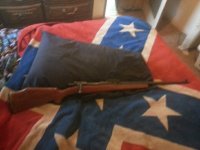Got this rifle in a trade and cant find the answers to my questions anywhere on google.
sorry if this is the wrong cat just got a few questions.
Rifle is a US Springfield Armory 1903 ser # 799,023 what ive learned is its from 1918 now
Question 1: Is how do i know if the barrel is original?
The stamp on barrel says SA 11-17 A and has the bursting bomb mark.
Question 2: The stock is not original it is an old wooden stock looks to be a sport style. My question is is there any place i can by an 1918 stock for it to bring it back to as original as possible looking? And would this increase any value?
As of now i plan to keep it. It fires and functions great. (Yes i know the low numbers/high numbers debate) but id like to make it as original looking as possible while still using it. But would like to keep the value up as much as possible incase i decide to sell.
Thanks in advance for any help!
sorry if this is the wrong cat just got a few questions.
Rifle is a US Springfield Armory 1903 ser # 799,023 what ive learned is its from 1918 now
Question 1: Is how do i know if the barrel is original?
The stamp on barrel says SA 11-17 A and has the bursting bomb mark.
Question 2: The stock is not original it is an old wooden stock looks to be a sport style. My question is is there any place i can by an 1918 stock for it to bring it back to as original as possible looking? And would this increase any value?
As of now i plan to keep it. It fires and functions great. (Yes i know the low numbers/high numbers debate) but id like to make it as original looking as possible while still using it. But would like to keep the value up as much as possible incase i decide to sell.
Thanks in advance for any help!

